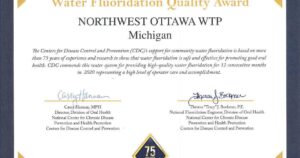Fluoridation Weekly Review #22
Oneida Council Rejects Fluoridation

The Common Council in Oneida, NY voted unanimously at their March 7th meeting not to study the possibility of introducing fluoridation chemicals to their water system.
The City’s Water Board wanted approval to apply for a state grant to study the economic and technical feasibility of starting fluoridation, but councilors noted that residents had twice previously voted against the policy, overwhelmingly.
“We didn’t want to spend money and time to look at this for a third time, when we know residents are opposed,” Councillor Tom Simchik said. “Even though it would be a state-funded study, it’s still taxpayer money — so why waste it?” he said, according to a March 9 report in the Daily Sentinel.
69 Michigan water systems receive fluoridation award, but what of the other 1391?

The Michigan Department of Health and Human Services has announced that 69 community water systems have received the Centers for Disease Control and Prevention’s (CDC) Water Fluoridation Quality Award, but this represents less than 5 percent of all the water systems in the state.
According to the department, “The award recognizes those communities that maintain a consistent level of optimally fluoridated water throughout calendar year 2021.”
The CDC’s My Water’s Fluoride database, which compiles information provided by the states, lists 1460 community water systems in Michigan. Does the small number of awardees mean that the vast majority of the systems don’t maintain a consistent level of fluoride? Even if half the systems were small ones associated with recreational parks or prisons or were systems that receive water from one of the awardees, it seems that less that less than 10 percent of water systems maintain consistent levels of fluoride.
The CDC did not respond to a reporter’s query on the matter.
Source: https://www.michigan.gov/mdhhs/inside-mdhhs/newsroom/2022/12/16/fluoridation
Oklahoma Senator Introduces Bill To Repeal Fluoridation

A Republican state senator from Broken Arrow has introduced a bill that would ban the fluoridation of drinking water supplies in Oklahoma.
Sen. Nathan Dahm, who introduced the bill, Senate Bill 165, has written on Facebook, “If individuals want to use fluoride there are ways they can access it. But the entire population shouldn’t be forced into it,” according to a report January 13 on radio station KOSU.
The radio report was somewhat garbled, mistaking micrograms for milligrams and then first reporting the highest level of naturally occurring fluoride as 0.59 micrograms [sic] per liter in Elk City, but then noting Bluejacket (a naturally fluoridated town of fewer than 300 people) has 3.35 micrograms [sic] per liter. The reporter then mistakenly writes, “The Environmental Protection Agency enforces a maximum limit of 4 milligrams of fluoride per liter, since that’s the concentration where fluoride can become a problem. That’s over 1000 times more fluoride than any Oklahoma water supply contains.”
Massachusetts Petition Calls For Due Diligence During Boston-Area Fluoride Suspension

Phone calls and emails are needed to support a new petition to the Massachusetts Water Resources Authority (MWRA) Board of Directors, who oversee the water supply for Boston and surrounding towns, asking it to perform due diligence regarding fluoride’s adverse health effects. The MWRA has temporarily suspended water fluoridation for three months to install new fluoridation equipment.
Petition author Karen Spencer of Leominster requests consumers contact the agency, state representatives and the press to call for proper evaluation of fluoride’s damage to human health. She can be reached at: KFSpencer@Comcast.net
In an email to the authority, Spencer writes, “the MWRA should be wary of allowing itself to fall victim to the sunk cost fallacy,” which she defines as “a phenomenon in which an individual or organization is reluctant to abandon or let go of a course of action due to the monetary, physical, or emotional investment they have already made. It is related to loss aversion and status quo bias and can result in improper long-term strategic planning decisions based on short-term committed costs.”
Click here to see the petition sent to MWRA on March 16, 2023:
If you are in any of the MWRA communities, especially those in the Carroll Plant district, write both your community DPW (look on your city website)
and ask that they support the petition the MWRA to end fluoridation,
phone and email the MWRA asking that they end fluoridation or at least
not spend any more money updating the Carroll Plant with new
fluoridation infrastructure. We might not win this battle since the
construction is due to begin, but this is an excellent opportunity to
educate these decision makers. A few strategic MWRA emails: beverly.anderson@
New Zealand Cost Estimates For Starting Fluoridation Rise Sharply

Many of the district councils in New Zealand that face an order from the national government to implement water fluoridation have found that the cost of doing so has become much more expensive in recent months.
According to a report in the Nelson Mail, January 7th nine of the 14 councils that were ordered to fluoridate in July, “said the projected costs had risen, with increasing costs for constructions and materials among the main reasons.”
The newspaper reported, “The biggest cost increases were at the Western Bay of Plenty District Council, where the anticipated cost of fluoridating its Anthentree supply had risen 230% to $923,962, while the cost at Wharawhara had gone up 235% to $938,587.”
“Implementation costs have increased since July due to the economic environment currently being experienced, with increased costs for supplies and infrastructure,” said E.J. Wentzel, a utilities operations manager.
The paper reported, “The Whangarei District Council faced a 29% increase; Waitaki District Council 51%; Rotorua Lakes Council 19%; New Plymouth District Council 58%; Nelson City Council 4.7%; and Far North District Council 64%. The Kawerau District Council and Hastings City Council also indicated that costs would increase but could not say by how much.”
“Rotorua Lakes Council manager of infrastructure networks performance Eric Cawte said its estimated costs had risen to $1.6m based on concept designs,” according to the report.
“The new estimated costs have factored in material and labor cost escalations since then, identification of geotech and survey requirements, and increased allowance for health and safety systems and quality assurance monitoring,” Cawte said.
Polish Investigators Concerned That Fluoride May Enhance Glioblastoma

Fluoride exposure may be contributing to the development of a particularly deadly form of cancer, according to a new report.
Glioblastomas are a type of brain tumor that differs in its biology from other forms of cancer, and has been resistant to radiation and chemotherapy.
Writing in the International Journal of Molecular Sciences January 13, researchers from the Pomeranian Medical University and the University of Szczecin summarize recent research on the effect fluoride has on many biochemical reactions in cells, and express concern that it has been ignored as a possible contributor to tumor development.
The report contains a detailed discussion of the many ways fluoride interacts with the molecular biological processes involved in glioblastoma formation and tumor development.
“Although the data currently available is incomplete on many issues, it appears that fluoride may affect signaling pathways involved in the processes of apoptosis [cell death], autophagy [cellular self-destruction], inflammation, and chemoresistance of glioblastoma cells. Thus, this compound has the potential to promote the growth and invasiveness of gliomas,” they write.
“The negative impact of fluoride on the central nervous system in children and the growing incidence of pediatric brain tumors since the mid-1980s should serve as the most powerful motivations in our efforts to explain this phenomenon,” they conclude.
Source: https://doi.org/10.3390/ijms24021558
•• Michael Dolan can be contacted at <mdolan.ecsn@outlook.com>
•• The archives of The Fluoridation Review are available at: https://
No comments:
Post a Comment